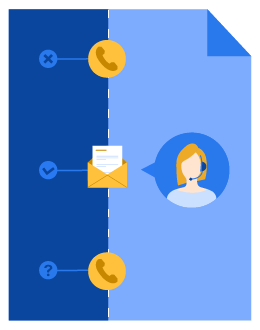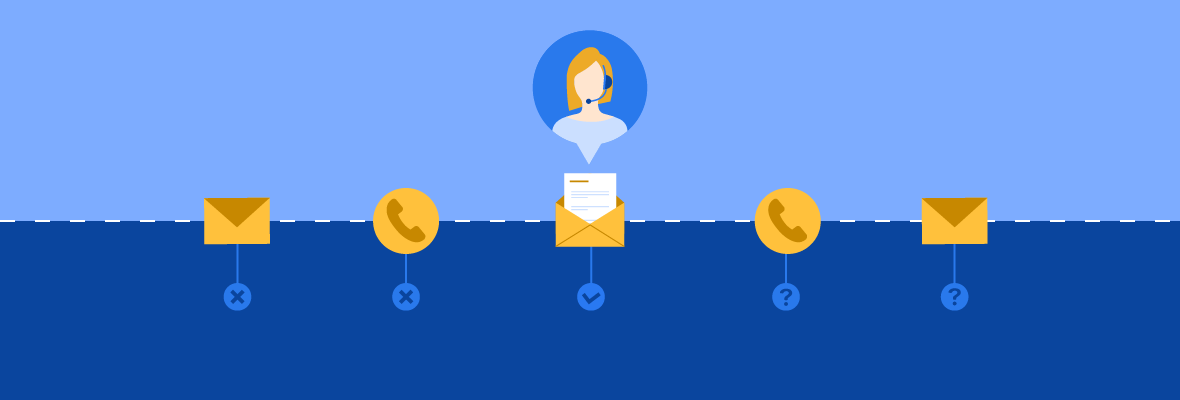Maintaining an active sales pipeline is key to sustainable business growth. To stand out from the crowd, you must find a sustainable way to follow up with prospects — even when they do not seem engaged initially. This is where a strong sales cadence comes into play.
In this post, we’ll discuss:
- What is a sales cadence?
- The EBQ Touch Cadence
- How to build your prospecting cadence

Download the Dial Cadence Cheat Sheet
Learn the four key components that make a strong sales cadence with our downloadable PDF.
What is a sales cadence?
A sales cadence is a sequence of touchpoints designed to move prospects down a sales funnel with the least resistance.
“Resistance” in the sales world means any indications of a prospect losing interest in your solution, such as:
- Unsubscribing to your marketing emails
- Neglecting your sales phone calls
- Not opening any of your emails
So what does a strong sales cadence look like? Ideally, it should be flexible, persistent, and utilize multiple communication channels.
The EBQ Touch Cadence
Since 2006, our sales development experts looked for ways to create the best outreach sales cadence. More than 87 million dials and 4000 lead generation projects later, we’ve created the EBQ Touch Cadence.

Notice how we never specified the waiting period between each touch point. We will later discuss how you will be able to figure out how long to wait between each connection attempt.
How to use the EBQ Touch Cadence
This sales cadence is designed for both cold and warm prospects. From our experience, five touchpoints should be more than enough to gauge a prospect’s interest. If a prospect is still unresponsive after five connection attempts, you will need to put them in a cool-down period before attempting to connect again.
1. Send a voicemail and email message
Deliver a short elevator pitch introducing your company to the prospect.
2. Call
Call the decision-maker and ask for a sales appointment.
3. Call and send email
Call and send your prospect an email with your value proposition and why your solution answers their problem.
4. Call
Since the average B2B buyer will reject a proposal four times before agreeing to invest, continue calling the prospect.
5. Send final voicemail and email message
Send one last voicemail and email to let them know this will be your final attempt to connect with them for now.
EBQ Tip: There needs to be a waiting period between each connect attempt, and this waiting period will ultimately depend on your current business circumstances and prospect interest. Visit Chapter 6 of the Ultimate B2B Appointment Setting Guide for more sales cadence best practices.

Subscribe to EBQ's Bimonthly Newsletter

Subscribe to EBQ's Bimonthly Newsletter
How to build your prospecting cadence
Now that you know how to use the EBQ Touch Cadence, let’s take a step back and examine how you can build your own sales cadence process.
1. Build your target personas
In order to effectively connect with your prospects, you must empathize with their challenges and understand their role. Ask yourself:
- Who is your solution built for?
- Who ultimately agrees to invest in your solution?
- What are their decision drivers?
- What keeps them up at night?
The more you drill down on your personas, the stronger your outreach attempts will be. For more actionable tips on how to create better targets, check out “10 Components of a Well-Defined B2B Buyer Persona.” There, we’ll dive into each step to creating a 360˚ view of your buyers and identify ways to connect with their pain points.
2. Consider your universe size
Your touch cadence length will vary depending on the size of your industry and current contact database. From our experience, larger universes allow for more time between each touch point.
That said, you need to be critical of where you get your contact data from. Otherwise, you risk burning through your contact database while spinning your wheels. In Chapter 8 of our Ultimate B2B Appointment Setting Guide, we dive into how to identify if you need a new data provider.
3. Consider your SDR team size
It goes without saying that the more SDRs you have on your team, the more touch points you can make in a shorter period of time. Therefore, your sales cadence length will decrease as your SDR team expands.
However, this is heavily dependent on how strong your SDR team is. If you’re looking to build a stronger team of appointment setters, consider partnering with EBQ. With over 16+ years of experience in the sales development industry, we know how to seamlessly integrate our proven processes with your unique business needs. Visit our B2B Appointment Setting Services page to learn more.
4. Create a lead qualification rating system
A lead qualification rating system allows you to quantifiably assess how interested a prospect is. We dove into how to qualify leads in Chapter 4 of our Ultimate B2B Appointment Setting Guide.
At EBQ, we use this rating system:

Based on how close a prospect is to a sales meeting, your touch cadence will vary in length. For warmer prospects, you’ll want to act quickly — as you want to strike while the iron is hot.
Here’s an example of what a warm versus cold prospecting touch cadence might look like:

5. Evaluate your process for conversion
As you assess your SDR team’s success, you should optimize your process for conversion.
Here are four quick tips on how to be as sales-efficient as possible:
- Utilize an all-bound SDR team: By combining the inbound and outbound sales development responsibilities into one team, you reduce the risk of miscommunication and cold-calling burnout
- Allow SDRs to have full access to salesperson’s calendar: While on a cold call, the SDR should be able to seamlessly block time on a salesperson’s calendar for a product demo or sales meeting
- Perform warm handoffs during sales meetings: The SDR should introduce the prospect to the salesperson during a product demo/sales meeting for a better customer experience
- Treat all prospects as decision-makers: By speaking to all prospects with the utmost respect, we noticed that the gatekeepers are more inclined to point you in the right direction
6. Rinse and repeat
Once the prospect has gone through the entire sales cadence, you need to put them in a waiting period before attempting to contact them again.
Typically, we recommend you rinse and repeat your sales cadence in a 3, 6, or 12-month timeframe. This cooldown period will ultimately depend on three factors: your universe size, your SDR team size, and your prospect’s interest level.

Download the Dial Cadence Cheat Sheet
Learn the four key components that make a strong sales cadence with our downloadable PDF.
TLDR; How to build a touch cadence
Sales cadences aren’t just about reaching out to prospects, they’re also about creating a structured and effective plan that nurtures relationships, drives engagement, and ultimately results in conversions. In this post, we explored how to create a sales cadence that maximizes results and boosts your sales performance.
These six steps are:
- Build your target personas
- Consider your universe size
- Consider your SDR team size
- Create a lead qualification rating system
- Evaluate your process for conversion
- Rinse and repeat
If you need help strengthening your sales development process, you should join forces with EBQ. Our experienced appointment setters understand how to stay professionally persistent without burning through your contact database. Contact one of our Business Consultants to learn how we can accelerate your sales efforts.


